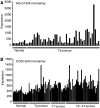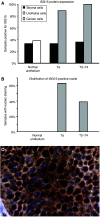Stage-associated overexpression of the ubiquitin-like protein, ISG15, in bladder cancer
- PMID: 16641915
- PMCID: PMC2361278
- DOI: 10.1038/sj.bjc.6603099
Stage-associated overexpression of the ubiquitin-like protein, ISG15, in bladder cancer
Abstract
Bladder cancer is among the most prevalent malignancies, and is characterised by frequent tumour recurrences and localised inflammation, which may promote tissue invasion and metastasis. Microarray analysis was used to compare gene expression in normal bladder urothelium with that in tumours at different stages of progression. The innate immune response gene, interferon-stimulated gene 15 kDa (ISG15, GIP2), was highly expressed at all stages of bladder cancer as compared to normal urothelium. Western blotting revealed a tumour-associated expression of ISG15 protein. ISG15 exhibited a stage-associated expression, with significantly (P<0.05) higher levels of ISG15 protein in muscle-invasive T2-T4 tumours, compared with normal urothelium. Although ISG15 is involved in the primary immune response, ISG15 expression did not correlate with bladder inflammation. However, immunohistochemical staining revealed expression of ISG15 protein in both cancer cells and stromal immune cells. Interestingly, a significant fraction of ISG15 protein was localised to the nuclei of tumour cells, whereas no nuclear ISG15 staining was observed in ISG15-positive stromal cells. Taken together, our findings identify ISG15 as a novel component of bladder cancer-associated gene expression.
Figures





References
-
- Akazawa T, Masuda H, Saeki Y, Matsumoto M, Takeda K, Tsujimura K, Kuzushima K, Takahashi T, Azuma I, Akira S, Toyoshima K, Seya T (2004) Adjuvant-mediated tumor regression and tumor-specific cytotoxic response are impaired in MyD88-deficient mice. Cancer Res 64: 757–764 - PubMed
-
- Bolstad BM, Irizarry RA, Astrand M, Speed TP (2003) A comparison of normalization methods for high density oligonucleotide array data based on variance and bias. Bioinformatics 19: 185–193 - PubMed
-
- Bringuier PP, Tamimi Y, Schuuring E, Schalken J (1996) Expression of cyclin D1 and EMS1 in bladder tumours; relationship with chromosome 11q13 amplification. Oncogene 12: 1747–1753 - PubMed
-
- Czerniak B, Li L, Chaturvedi V, Ro JY, Johnston DA, Hodges S, Benedict WF (2000) Genetic modeling of human urinary bladder carcinogenesis. Genes Chromosomes Cancer 27: 392–402 - PubMed
Publication types
MeSH terms
Substances
Grants and funding
LinkOut - more resources
Full Text Sources
Other Literature Sources
Medical
Miscellaneous

